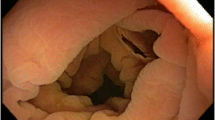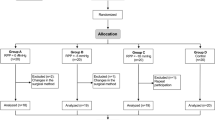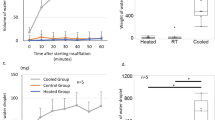Abstract
A serious complication for any thermal radiofrequency ablation is thermal injury to adjacent structures, particularly the bowel, which can result in additional major surgery or death. Several methods using air, gas, fluid, or thermometry to protect adjacent structures from thermal injury have been reported. In the cases presented in this report, 5% dextrose water (D5W) was instilled to prevent injury to the bowel and diaphragm during radiofrequency ablation. Creating an Insulating envelope or moving organs with D5W might reduce risk for complications such as bowel perforation.



Similar content being viewed by others
References
Livraghi T, Solbiati L, Meloni F, et al. (2003) Treatment of focal liver tumors with percutaneous radio-frequency ablation: Complications encountered in a multicenter study. Radiology 226:441–451
Diehn FF, Neeman Z, Hvizda JL, et al. (2003) Remote thermometry to avoid complications in radiofrequency ablation. J Vase Intervent Radiol 14:l569–1576
Farrell MA, Charboneau JW, Callstrom MR, et al. (2003) Paranephric water instillation: A technique to prevent bowel injury during percutaneous renal radiofrequency ablation. Am J Roentgenol 181:1315–1317
Yamakado K, Nakatsuka A, Akeboshi M, et al. (2003) Percutaneous radio frequency ablation of liver neoplasms adjacent to the gastrointestinal tract after balloon catheter interposition. J Vasc Intervent Radiol 14:1183–1186
Gilliams AR, Lees WR (2003) Liver isolation during radiofrequency ablation of liver tumours. Radiological Society of North America Annual Meeting 2003, Radiology (Suppl):S589
Shibata T, Yamamoto Y, Yamamoto N, et al. (2003) Cholangitis and liver abscess after percutaneous ablation therapy for liver tumors: Incidence and risk factors. J Vasc Intervent Radiol 14:1535–1542
Rhim H, Yoon K, Lee JM, et al. (2003) Major complications after radio-frequency thermal ablation of hepatic tumors: Spectrum of imaging findings. Radiographic 23:123–136
Kam AW, Littrup PJ, Walther MM, et al. (2004) Thermal protection during percutaneous thermal ablation of renal cell carcinoma. J Vasc Intervent Radiol 15:753–758
Choi D, Lim HK, Kim MJ, et al. (2004) Therapeutic efficacy and safety of percutaneous radiofrequency Ablation of hepatocellular carcinoma abutting the gastrointestinal tract Am J Roentgenol 183:1417–1424
Goodacre BW, Savage C, Zwischenberger JB, et al. (2002) Salinoma window technique for mediastinal lymph node biopsy. Ann Thoracic Surg 74:276–277
Kapoor BS, Hunter DW (2003) Injection of subphrenic saline during radiofrequency ablation to minimize diaphragmatic injury. Cardiovasc Intervent Radiol 14(3)A:302–304
Gananadha S, Morris DL (2004) Saline infusion markedly reduces impedance and improves efficacy of pulmonary radiofrequency ablation. Cardiovasc Intervent Radiol 27(4):361–365
Acknowledgment
This work was supported in part by the Intramural Research Program of the NIH.
Author information
Authors and Affiliations
Corresponding author
Rights and permissions
About this article
Cite this article
Chen, E.A., Neeman, Z., Lee, F.T. et al. Thermal Protection with 5% Dextrose Solution Blanket During Radiofrequency Ablation. Cardiovasc Intervent Radiol 29, 1093–1096 (2006). https://doi.org/10.1007/s00270-004-6216-2
Published:
Issue Date:
DOI: https://doi.org/10.1007/s00270-004-6216-2




